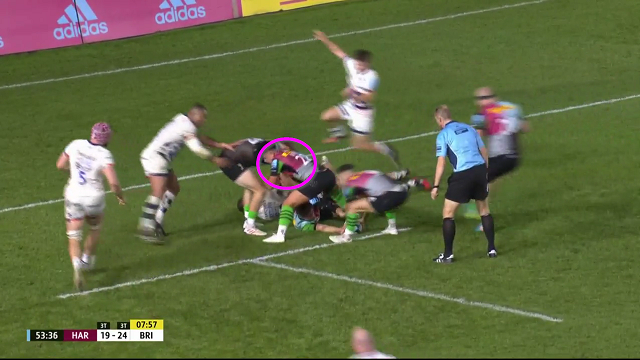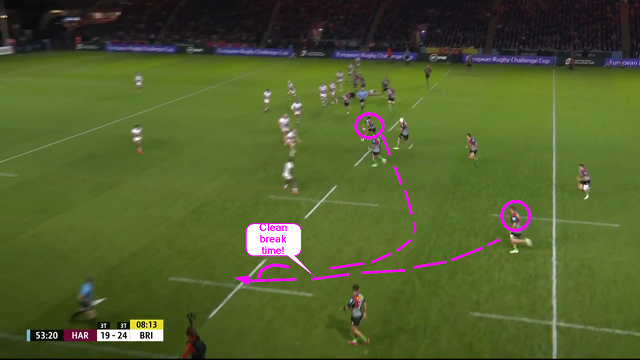Why the modern maverick 10 must be able to multi-task
Maybe the French were ahead of the game after all, when they began picking half-backs who could happily play both number 9 and number 10 with equal facility in the first two decades of professionalism.
Jean-Baptiste Elissalde, Jean-Marc Doussain and Frédérick Michalak are among a number of prominent French players who could produce a performance at both positions. More recently, both Sébastian Bézy and Antoine Dupont (typically scrum-halves) have often finished games for their club Stade Toulousain, usually with Dupont moving to number 10.
That kind of interchangeability hints at an expansion of the number 10’s role, especially since the introduction of the new guidelines at the tackle area in June 2020. With the production of increasingly quick ball from the ruck, the first five-eighth) has found him or herself fulfilling a much greater variety of roles than before.
Instead of sitting back and expecting to direct the play on the bulk of phases, the man in the number 10 spot now has to get his hands far dirtier. They have to be able to multi-task and turn their hand to a number of different jobs, often within the same sequence of play.
Even the more mercurial ‘mavericks’ at the spot have accepted the need for evolution. As a resurgent Quade Cooper said recently:
“If you look at number 10’s around the world now, you’ve got Finn Russell, Marcus Smith, Beauden Barrett, Richie Mo’unga."
“Electric, entertaining players who have a skill-set other than just standing in the pocket and kicking the ball. It’s only over the last five or so years that those guys are getting respect and their faces are starting to fit."
“Maybe before, you would be written off as a maverick who is unreliable. The more those guys are empowered and the more they continue to grow, the more kids will come through and want to play like them."
“The media and current players need to get behind these players and support them, rather than smash them and bury them if they have one bad game."
“Hopefully I will play against Marcus Smith one day, but either way I’ll continue to love the work he does.”
Neither Quade Cooper nor Marcus Smith do much waiting around, hoping to produce one memorable moment of magic with ball in hand. On defence, both can be discovered participating in counter-rucks:
You do not have to be wearing the jersey of a number 7, or number 12 or 13, if you are the second man in on the counter-drive.
On the attacking side of the ball, there is a growing willingness to become the man ‘sweeping the sheds’, replacing that insistence on being the architect of a scoring play:
In the first example, Quade adds himself as the second man at the cleanout, and there is evident confidence that two props (Angus Bell and Taniela Tupou) can do the playmaking on the short-side. That confidence turns out to be well-founded, with Bell’s all-in-one transfer and Tupou’s no-look pass putting Marika Koroibete in for the try.
In the second instance, Harlequins’ outside-half Marcus Smith adds himself as second man at the breakdown, and leaves the playmaking to his number 8 Alex Dombrandt on the following phase.
Let’s finish with a couples of seminal examples from the young gun on the block, Marcus Smith:
Smith is the playmaking first receiver on the initial phase, then he scuttles in to the base become an acting scrum-half on the second. There is no time to do anything else.
One long scoring sequence in the recent Gallagher Premiership game between Harlequins and the Bristol Bears provided a perfect illustration of how quickly the role of a modern number 10 is evolving, with so much superfast continuity in the game.
Marcus Smith starts in the conventional first receiver role, then runs all the way across to the left 5 metre line, past four other Quins players, in order to be able to receive a line-breaking offload from Dombrandt.

It doesn’t end there: after making the break, he delivers a deft offload to his left wing (number 11 Cadan Murley) before adding himself as a vital second man to the next goal-line cleanout.

In the space of only 15 seconds, Marcus Smith has played four different roles on attack: primary distributor, key support player, off-loader and cleanout arrival. It is all a very long way from the notion of a number 10 who only wants to be a playmaker.
Summary
The interchangeability of roles flagged by the French as long ago as the early 2000’s, with their swapping of 9 and 10 at the base of the ruck, is developing apace with the new ruck guidelines producing such quick deliveries for next phase.
A number 10 will need to be able to fulfil a number of roles: the two Harlequins’ first five-eighths against Bristol (Smith and Tommaso Allan) attended one in every six rucks as cleanout support, passing or running from the base. Marcus Smith has moved the goal-posts even further out by adding so many extra involvements in support and at the ruck. The times, they are a-changing at number 10.












.jpg)

.jpg)







